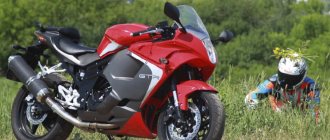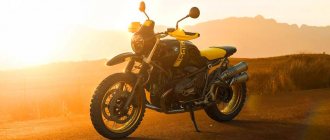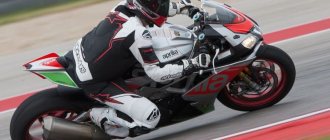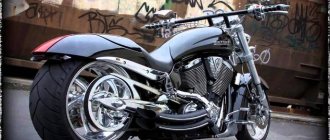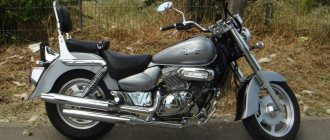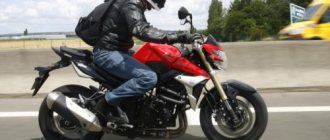Universal enduro “Hyosung XRX125” and “Zongshen ZS200GY”
Previously, any foreign-made motorcycle was a luxury. But the market for expensive models has long been filled, and now dealers are expanding the sector of devices that cost several times less than cars. “Sales of affordable motorcycles are growing by hundreds of percent every year,” notes Yulia Leskova, general manager of the Bike Land salon. — Equipment from Korea and China has a favorable price/quality ratio. According to our marketing research, even people who have never thought about purchasing a motorcycle buy it.” Traveling around the city, transport for the dacha (especially if there is off-road conditions), mastering the basics of driving - these are just some of the areas of application of the Korean enduro “Hyosung XRX125” and the Chinese “Zongshen ZS200GY”. Of course, affordable cheese can only be found in a mousetrap: these two cheap devices are inferior in some respects to their Japanese counterparts..
Unexpectedly good package
SINCE there are two motorcycles, I invite one of the salon managers on a trip. He put on a cross-country uniform and saddled the Chinese “Zongshen ZS200GY”. I start the Hyosung XRX125 engine. Moreover, I start with an electric starter (there is also a kick starter) - equipment that is somewhat unexpected on a motorcycle costing just over $3,000.
At first, the four-stroke single-cylinder engine, as they say, “didn’t work.” He reacted to the gas as apathetically as a traffic police inspector lurking in ambush with a speed gun reacted to a sport biker flying past. My partner came up to me and said, without going into technical details, that the engine was new and he should “sneeze.” Indeed, five minutes of good driving on the highway with the throttle fully open - and the engine began to work more cheerfully, honestly giving its 12 “horses”. They are quite enough for vigorous movement in space, since the dry weight of “Hyosung” is 116 kg.
Having accelerated on the highway to the required 100 km/h according to the passport, I begin to carefully “collect” all the potholes and wells. The motorcycle is not afraid of bumps - the cross-country roots show. I especially liked the performance of the front fork. It is an advanced one - an “inverted” type, which is again somewhat unexpected on an affordable motorcycle. In general, for its price, “Hyosung” is well equipped. The only thing that gives away the cheapness of the motorcycle is the rear drum brake, not a disc one. However, it is quite enough for light braking. The steel frame felt unshakable in a straight line, even when I deliberately ran the wheels along cracks in the asphalt.
The chassis also performed well on the cross-country track. There was no puncture in the suspension, even when the bike landed hard after jumping off ramps. The standard tires in which the motorcycle is shod emphasizes its belonging to two elements - off-road and asphalt. Tires are cut into small pieces. This is a good compromise for public roads and dry ground. But, if the ground is wet, with such tires you need to keep an eye on the motorcycle. It rained at night over the track where we were riding, and the tread capabilities were now clearly not enough even for straight-line movement. As soon as you open the gas, the motorcycle tries to spin around the front wheel. If you are going to do a lot of off-road driving, it makes sense to put on cross-country tires - “Hyosung” will be unrecognizable.
For its price, “Hyosung” is surprisingly well equipped.
Hyosung RT125D – TEST
2013 onwards, 124.5 cm3, 13.6 l. s., 125 kg, 135,000 rub.
text: Anton Vlasov photo: Nikita Kolobanov
In the photo: Anton Vlasov
»The outstanding market success of the Yamaha TW series motorcycles doomed these fun dual-purpose machines to be copied and even cloned by other Asian manufacturers. The Hyosung concern, which since 2008 has been releasing its vision of the Yamaha TW concept - the RT125D model, did not miss the opportunity to capitalize on the popularity of the Japanese motorcycle. But how good is the Korean copy and can it become a worthy alternative to the original model, which, unlike the RT125D, is not officially presented on the Russian market?
Hyosung RT125D is an almost complete copy of the popular Yamaha TW125 dual-purpose motorcycle. Along with the construction and design, Korean craftsmen transferred into their creation the original concept of the progenitor, which made the Japanese motorcycle so beloved around the world. The uniqueness of the devices of the TW family lies in the features inherent only to these unusual cars: spoked wheels with “chubby” and wide tires, a low seat height, a simple 1-cylinder engine, plus a general primitiveness, and therefore reliability of the design. Due to non-standard wheels and reduced transmission ratios, these funny all-terrain vehicles are able to make their way into such off-road jungles and climb such mountains that it is unclear why the TW125 has not yet been proposed as a rover for the NASA space program?.. The motorcycle test took place. December 25... in Moscow. In my memory, such a gift of fate was for the first time: never before on New Year’s Day has the air temperature in the capital risen to a confident +5 °C! So global warming is by no means a mythical phenomenon from the series of the notorious end of the world, which has been postponed and postponed several dozen times over the past couple of years, but a real process on a planetary scale. Who knows, maybe already in 2015 the motorcycle season in Moscow will not be closed for the winter holidays?
The same as Since the RT125D test tests took place under somewhat unusual conditions and were limited not only by temperature, but also by time frames, I’ll immediately dot the “i”, “ÿ” and, of course, “ö”: this material does not pretend to a comprehensive presentation of the motorcycle, but rather a first introduction to the model. Of course, with the arrival of the new motorcycle season in the capital region, and perhaps even earlier, we will definitely test the Korean “all-terrain vehicle” with all passion! And one more note: in the text of the article I will deliberately avoid comparing Hyosung and Yamaha motorcycles, because otherwise the editorial proofreader will get tired of removing the phrases “same as”, “exactly repeating” or “no different” after me... So I’ll pretend that I’ve never driven a TW125, never seen it, and am generally unaware of its very existence. The ergonomics of the Korean motorcycle are designed for people of average height and very moderate build. Therefore, if you, like the mafia, have long arms, no smaller legs and not the most slender body weighing about a hundredweight, you shouldn’t even try: the Hyosung RT125D will hardly seem comfortable. Which is quite expected: have you ever heard of two-meter Koreans with size 45 feet?.. However, large individuals are usually not interested in motorcycles with 125 cc 13-horsepower engines.
The design of the model evokes mixed feelings. On the one hand, the RT125D looks somewhat like a toy, and when you see it, you want to fold your arms on your chest, tilt your head to the side and sweetly say, “Oh-oh, how cute!..” Fans of brutal iron will definitely not like the Hyosung all-terrain vehicle. On the other hand, although all the parts and components of the model can hardly be called beautiful and elegant, the assembled design looks harmonious, and the “chubby” wheels are, I would say, attractive. Also, the metal crankcase protection, installed as standard, definitely suits the motorcycle very well: this small but significant touch in the design enhances the off-road component of the Hyosung RT125D’s appearance.
Fighting the flow The motorcycle is equipped with a simple 1-cylinder 4-stroke engine with a displacement of 124.5 cm3. Interestingly, the maximum power of the power plant declared by the manufacturer (13.6 hp at 10,000 rpm) exceeds the performance of the original Yamaha engine! But the main difference is a completely different type of timing belt: the Korean engine has two overhead camshafts and four valves... However, in reality, of course, there is almost no difference with the TW engine, and it is hardly worth paying attention to all these numbers and indicators. Although the same Japanese motorcycle is available in the aftermarket in versions with 200 and 225 cc engines, while the Hyosung is available only in the 125 variant. Taking into account the specific concept of the device, as well as taking into account the target audience of the model, the 13-horsepower engine is clearly in its place - the character (or rather, lack thereof) of the Korean engine is ideal for the purpose of the motorcycle. Due to the reduced gear ratios of the transmission, the Hyosung RT125D is able to drive slowly but surely in the most difficult on-road and off-road conditions, surprising the pilot with its willingness to push the Korean all-terrain vehicle forward even in third gear at 15 km/h! The downside of this Order of Honorary Pensioner is the low maximum speed (from 115 to 125 km/h, depending on the direction and strength of the wind...) and the need to change gears frequently. The first stage of the gearbox is so short that you can move away in the second.
One of the undoubted advantages of the Hyosung engine is its ultra-low fuel consumption: with a particularly greedy approach to piloting a motorcycle, it is quite possible to achieve a fantastic 2.5 liters per 100 km! Although this is, of course, not easy to do, because in order for the RT125D not to be mocked in traffic by old Soviet trucks and Volgas from the 70s, the motorcycle engine must be mercilessly “twisted”. And when piloting in the “MotoGP 125 cm3” style, the appetite of the Korean “single-barrel” increases significantly. The performance of the gearbox was not impressive: the engagements are uncertain, the gearbox foot travel is long, the feedback is mediocre. Although it is worth making allowances for the fact that the test motorcycle was completely new and no flies were breeding on it - usually for equipment in this price category it is very critical how well the engine was run in according to the instructions, and if the owner performs this ritual properly, then after the cherished TO-1 and the gearbox, and in general the power plant itself begins to work a little better.
Mind games The most interesting thing about Korean technology is that you will never know your motorcycle completely. After all, identifying a third of the components of the Hyosung RT125D is a task from the series “Find, dig up and find out what kind of rags are from the 3rd century. BC e. rests under this stone slab”... So, for example, the model is equipped with a brake caliper from the “world famous” company TCIC (also, by the way, a Korean brand!), nameless (and therefore even more intriguing...) suspension brackets, a carburetor unknown to science and many other soul-stirring things a paleontologist passionate about parts and components. However, such mystery does not prevent all these elements from properly performing their functions! In general, the soft suspension was a pleasant surprise: for such budget equipment it is very rare that when braking the fork does not fold all the way, and during an innocent jump from a low curb the monoshock absorber does not pierce!
The Hyosung RT125D has a pendulum rear suspension, as usual, but lacks a lever system. But I don’t think there’s any need to grieve over this: the chassis of the Korean all-terrain vehicle has not become any better or worse. And several tests designed for me by the editorial photographer in order to get dynamic shots, the motorcycle passed with a rating of “not bad”: driving in and out of the curb, a small bounce on a bump, landing with a wheelie... - Hyosung had no special problems with this gentleman’s set. Although I did not feel the unearthly lightness, as in the television advertisement for hygiene products. The situation with brakes is similar: as long as you understand what kind of motorcycle you are riding and how much it costs, there are no problems. The work of the “wobbly” and uninformative 2-piston Korean caliper is taken for granted, and therefore even when slowing down innocently from 60 km/h in front of a traffic light, which is still at least 100 m away, the foot automatically activates the rear brake drum. Together, the “sweet couple” stops a 125-kilogram motorcycle very predictably and quickly. But you just have to get distracted for a second and soar in your dreams, imagining in place of the Hyosung RT125D at least a Yamaha WR450F in the supermoto version, and the braking system (as, indeed, many other elements of the Korean all-terrain vehicle) will no longer suit you and lead your mind to a disappointing conclusion: for 135,000 rubles you will hardly get a fast, sharp and maneuverable sports equipment... But the Korean motorcycle copes with its specific tasks perfectly! /
